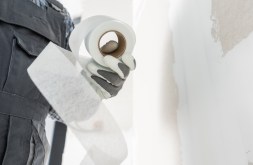Terrifyingly Freakish Facts About The Walking Dead
Since premiering on October 31, 2010, AMC’s hit television show The Walking Dead continues to captivate audiences. With over 100 episodes under its belt and an increasingly large universe of spin-off shows like Fear the Walking Dead and the upcoming teen-focused prequel series, it’s clear that the love for the show is as contagious as the flesh-eating disease it’s focused on. Still, there are many facts about the series that some fans don’t know.
Walker School
To create a convincing post-apocalyptic universe, the cast and crew have to make sure everything is as realistic as can be. For the extras on the show, this includes attending “walker school” to learn how to walk and act like walkers (The Walking Dead universe’s term for zombies).
In addition to extensive makeup and practical effects to transform actors into the undead, these workshops help the extras take their performances as walkers to the next level. It takes a lot more brains than zombies actually possess themselves.
Different Levels of Zombie Makeup
Greg Nicotero might be the key special effects makeup artist on The Walking Dead, but he’s got a leg up on other special effects artists in the business: He’s also an executive producer, which means he gets to make creative decisions just like a writer or director does.
For Nicotero, this includes meticulously planning different levels of zombie makeup — Hero, Midground and Deep Background. Heroes get the head-to-toe treatment, Midground walkers get prominent shadowing for soft-focus scenes and Deep Background extras simply receive masks — they’re just for backdrop purposes.
The Last Supper
Naturally, being a show with “dead” in the title, The Walking Dead deals quite heavily with mortality — not only because of the zombies constantly getting slain, but also because of the many main cast members who frequently cycle through the show as they succumb to the deadly walker virus.
When the time comes for a central character to die, the show performs a special ritual dubbed “The Last Supper.” All principal cast members gather together to share one last meal as a group before filming the soon-to-be-zombified character’s final scene.
Dealing With the Passage of Time
The world is already in a pretty bad state when The Walking Dead begins, but the show has been on the air for nearly a decade since then — the world is even worse off now. The crew has come up with a couple different ways to show this erosion.
For starters, the opening title of each season decays further and further as the show goes on. Comparing titles from the first through tenth seasons displays this. The makeup team also darkens the look of the walkers gradually each year.
West Georgia Correctional Facility
Creating convincing sets is a huge part of portraying a realistic and gripping drama. For this reason, The Walking Dead‘s crew wanted to ensure complete and total perfection when choosing the location for season three and the first half of season four.
When they couldn’t locate a pre-existing locale that fit the bill, the crew just decided to build one from scratch. The West Georgia Correctional Facility took two months to build and lasted a season and a half. When the show was done with the set, they took it all down like it never existed.
No End in Sight
Ten years in, it might seem like The Walking Dead would plan on coming to an end sometime soon. This isn’t the case, though — not even close. In fact, according to AMC CEO Josh Sapan, the show’s not even halfway finished.
In September of 2018, Sapan revealed that he and the network have plans to keep The Walking Dead alive for at least another decade, if not longer. This plan includes more seasons of The Walking Dead and Fear the Walking Dead, additional spin-offs and even a few movies.
Frank Darabont’s Universe
The Walking Dead developer Frank Darabont might not be a part of the show anymore, but it’s still very much a part of him. This is mainly due to the fact that many of his most trusted actors have been involved with the show at one point or another.
Five cast members of his 2007 horror film The Mist have appeared on The Walking Dead throughout its run, with two — Laurie Holden and Jeffrey DeMunn — appearing in other Darabont films like The Majestic, The Shawshank Redemption and The Green Mile.
Leeway With the Source Material
At this point, almost everyone knows that The Walking Dead originated as a comic book. However, even if an audience member is familiar with the comic books, there’s no way they’d be able to predict what’s going to happen next on the TV series.
This is because even though the writers are loyal to the main characters and basic arcs, the writers have the freedom to transfer certain fates onto other characters and move particular plots around on the timeline. With this, they’re always able to deliver surprises to viewers.
How Actors Learn Their Characters’ Fates
Some shows are so dedicated to maintaining secrecy onset that the writers withhold information from the cast and crew until the very last minute. Others trust their actors enough to keep the shows’ plot twists a secret. The Walking Dead falls somewhere in the middle.
Some of the show’s former cast members have reported that they knew of their fates at least a year in advance. Others told fans that they didn’t even know about their own characters’ impending doom until just a few weeks before filming their final scenes.
Unique Shooting Style
In this day and age, shooting with digital cameras is often the default. Some claim it’s the cheaper option compared to celluloid, but it really comes down to a matter of convenience. The Walking Dead is in the minority: The crew shoots on 16mm film.
From the very beginning, director of photography David Boyd and cinematographer David Tattersall have insisted on shooting on film. It gives a grainier, more old-fashioned look that fits the show’s zombie aesthetic perfectly. On the contrary, Fear the Walking Dead has always shot on digital cameras.
A Nearly Paperless Set
The Walking Dead might portray a world too far gone to be saved, but that doesn’t mean that the production crew has to adopt a similar nihilism. Producer Gale Anne Hurd single-handedly makes sure to keep things as environmentally friendly as possible.
Using the app Doddle, Hurd and the rest of the cast and crew share call sheets, scripts and other important documents that otherwise would’ve been printed. Not only does this create an almost paper-free set, but it also helps protect the spoiler-laden teleplays from leaking to the press.
The Walking Dead Webisodes
In addition to The Walking Dead and Fear the Walking Dead, AMC has released four separate web series as supplemental material between 2011 and today. Ranging anywhere from three to six parts in length, the webisodes provide some crucial information you can’t find on the show.
2011’s Torn Apart gives a backstory to one of the very first zombies that main character Rick Grimes kills. 2012’s Cold Storage follows other survivors in Atlanta. 2013’s The Oath provides an explanation for some graffiti seen in the pilot episode. 2017’s Red Machete contextualizes Rick’s infamous weapon.
The Future of Rick Grimes
The Walking Dead actor Andrew Lincoln had a very public departure from the show after its ninth season. Because he’s been with the show from the start, many fans were quite upset with his exit. AMC plans to remedy this, though.
AMC CCO Scott Gimple assured fans that Lincoln’s character Rick will return for three feature films, the first of which is set to begin production before 2019 ends. Universal Pictures plans to release the trio of films in theaters instead of opting to release them on television or streaming services.
Fear the Walking Dead’s Connection
While it was initially advertised as a spin-off, 2015’s Fear the Walking Dead was more of a prequel to The Walking Dead than a sister show. This is because (for the first few years, at least) no Walking Dead characters had any connection to Fear.
Once the third and fourth seasons came along, comic creator Robert Kirkman made sure to add two Walking Dead fan favorites to the cast of the prequel to establish a more solid link. Fans can expect more familiar faces in the future.
Future Walking Dead Spin-offs
Set to air in 2020, The Walking Dead‘s second spin-off show will head into the future to focus on a group of first-generation apocalypse survivors. It’s an interesting idea and one that’s sure to open the door for even more television crossovers down the line.
Calling themselves “Endlings,” the show will portray the zombie epidemic through the eyes of children born after the apocalypse began. Never knowing what life was like before walkers, the show may appeal to younger audiences and create a whole new generation of fans.
Fear the Walking Dead Webisodes
Much like The Walking Dead, Fear the Walking Dead has offered fans a few web series of its own. Unlike The Walking Dead, though, Fear‘s webisodes contain many more parts than all of The Walking Dead‘s various webisodes combined.
2015’s Flight 462 is a 16-part web series that follows a group of passengers onboard a commercial flight during the time of the zombie outbreak. 2016’s Passage is another 16-parter, this time following a new set of survivors. And 2019’s The Althea Tapes is a six-part series of Fear character interviews.
The Walking Dead’s Original Home
The Walking Dead has been at AMC for almost a decade now, but there’s an alternate reality in which this almost wasn’t the case. Before the show was sold to the network, creator Frank Darabont was shopping his pitch around to different outlets — namely, none other than HBO.
Known best for its hit dramas, HBO is no stranger to massively successful shows. That’s why it’s so surprising to find that the network actually passed on The Walking Dead over concerns that it’d be too violent (and Game of Thrones wasn’t?).
Substituting Guts for Food
When dealing with the undead — especially the type of undead that feasts on flesh — it’s important to have convincing-looking gore. In order to do this, the crew turns to the food pyramid. Walkers need nutrients too, after all.
For human guts, the crew uses chicken breasts. For flesh, they use ham soaked in vinegar. For vermin, they use a mix of gelatin and grape jelly. These measures ensure that the blood and gore look realistic while also making sure that the extras don’t have to consume anything too vile.
The Magic of CGI
While all the walkers are covered in intricate special effects makeup, the post-production crew still utilizes plenty of computer-generated imagery (CGI) in order to make things that much more convincing. This includes all kinds of green screens and special editing tricks.
For instance, depending on the time of year, post-production has to add or remove visible water vapor for exterior scenes. Every time an extra blinks, editors have to remove it. Armless zombies have to wear special green sleeves. Even the zombies’ grunts and growls are added in post-production.
Vastly Different Shooting Locations
From the very beginning, The Walking Dead has been proud to shoot in Georgia. No matter where the story takes the characters, behind the scenes they’ll always be in or around the Peach State. This isn’t the case with Fear the Walking Dead, though.
Initially shooting in California, Fear the Walking Dead has hopped all around North America since production began in 2015. From Los Angeles, California, to Vancouver, Canada, to Austin, Texas, the spin-off series refuses to sit still. It’s interesting to note the Midwest remains unexplored.
The Talking Dead
In a clever play on words, AMC debuted Talking Dead in 2011 following a rerun of the season two finale. An interactive program that gives audiences a chance to participate in the discussion along with the host and Walking Dead guest stars, the show is still airing in 2019.
While not nearly as many people watch Talking Dead as people do the show they’re discussing, AMC seems to have plenty of faith in the program — it was even expanded to include Fear the Walking Dead and some special episodes between respective seasons.
Critical Ups and Downs
The Walking Dead and its spin-off have never failed to bring in audiences by the millions, but the show isn’t always a critical darling. Rotten Tomatoes, a website that assigns scores to all kinds of entertainment by aggregating the critical consensus, has shown that critics are on a Walking Dead roller coaster.
The show’s first season debuted to an 88% positive score and dipped all the way down to a score of 63% for its seventh season. It then shot up to a series high of 91% for its ninth season.
The Walking Lawsuits
Given the size and success of The Walking Dead, it’s no surprise that the show has seen its fair share of lawsuits. Both former showrunner Frank Darabont and the mother of a former stuntman have taken the series and its network to court.
Darabont was fired by AMC in 2011 over claims that he couldn’t adjust to television after working in film for most of his career. The network and Darabont continue to go back and forth over a breach of contract. The same goes for the deceased stuntman’s mother.
Fear the Walking Lawsuits
Like the show it spun off from, Fear the Walking Dead has had a bit of legal trouble, too. Instead of breach of contract or safety concerns, though, Fear‘s lawsuit concerns intellectual property theft. Comic book creator Mel Smith felt the show ripped off his series Dead Ahead.
Because Fear partially took place on a boat during its second season, Smith felt he had enough evidence to sue the show and the network for ripping off his similarly set series. The lawsuit definitely has legs, at least according to Judge Lucy Koh.
Surprise Special Effects
From time to time, the crew wants to generate some genuine shock from the main cast. To do this, they occasionally set up stunts or surprises in certain scenes without filling the cast in first. One memorable instance happened during season four.
Special effects artists equipped a select few actors with prosthetic necks that oozed blood when sliced. When the deed was done, the cameras were ready and rolling to capture the authentic look of fear on the actors’ faces as the blood flowed from the deceased characters’ wounds.
Drastic Differences in the Timeline
Even though most seasons of The Walking Dead are 16 episodes split into two parts, the amount of time that passes within the show is always changing. Some seasons move through time fast, while others take their time.
For instance, many fans theorize that the pilot alone spans five weeks because of Rick’s coma. On the contrary, the second half of season four takes place during the course of eight days. The first half of season five takes place over the span of four short days.
Rick’s Hand (or Lack Thereof)
The showrunners have taken creative liberties with the source material countless times, whether it be shifts in the fate of certain characters or the shuffling of events from page to screen. One of the biggest (and most notable) differences has to do with Rick’s right hand.
In the comics, Rick loses his hand pretty early on. It’s a very prominent character trait and one of the most recognizable parts of his appearance. However, the showrunners determined it’d simply be too hard (and too expensive) to remove Rick’s right hand digitally.
Suspension of Disbelief
Technically speaking, the show’s main actors shouldn’t look nearly as healthy and fit as they do on The Walking Dead. It’s excusable on Fear the Walking Dead because of the shorter distance between pre-outbreak and the present, but The Walking Dead‘s biggest suspension of disbelief lies in this unavoidable goof.
In a world where supplies are scarce and survival is the top priority, characters would be much more frail and malnourished than they appear. There’s nothing the cast can do about this, though — it would be ridiculous to expect otherwise.
Zombie-movie Influences
Despite its massive appeal and huge success, The Walking Dead is far from the first piece of popular zombie-centric entertainment. The show’s creators are well aware of this and, as a result, often pay homage to the titans that came before them.
Past episodes have referenced such horror films as 1978’s Dawn of the Dead, 1981’s An American Werewolf in London, 1982’s Creepshow and 1985’s Day of the Dead. With this, George A. Romero — arguably the pioneer of the contemporary zombie flick — is the one referenced most often in the show.
Scripted Show, Real Panic
While shooting a pivotal scene during the production of season one of The Walking Dead, actor Michael Rooker had to take to the roof with a sniper rifle. While everyone on set knew the context, people in the surrounding area did not. As a result, they called the police.
It didn’t take long for an Atlanta SWAT team to interrupt filming. They rushed the rooftop in an attempt to stop what they believed was a very serious situation. Luckily for all parties, there was never a real threat.





